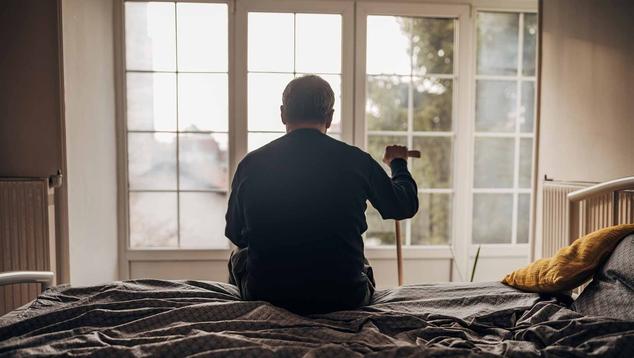Story Highlights
- Loneliness has been in steady decline nationally since early 2021
- Young adults, those in lower-income homes more likely to feel lonely
- Many detrimental aspects of wellbeing are linked to loneliness
WASHINGTON, D.C. -- Seventeen percent of U.S. adults report that they felt loneliness “a lot of the day yesterday,” continuing a general decline seen since 2020 and early 2021. Despite the decrease, the 17% represents an estimated 44 million American adults who are experiencing significant loneliness. These data are a part of the Gallup National Health and Well-Being Index.
The most recent results, obtained Feb. 21-28, 2023, are based on a web survey of 5,167 U.S. adults as part of the Gallup Panel, a probability-based panel of about 100,000 adults across all 50 states and the District of Columbia. The decline in reports of loneliness largely coincides with the COVID-19 vaccine era, when social distancing and isolation protocols became less common. As recently as March 2021, 25% of respondents reported experiencing loneliness the prior day.
Loneliness Highest Among Young Adults, Lower-Income Households
Young adults under the age of 30 (24%) and those in lower-income households earning less than $24,000 per year (27%) suffer higher levels of daily loneliness than their older and higher-income counterparts, according to the February 2023 survey.
In December 2020, 38% of young adults and 42% of adults in lower-income households reported being lonely. Since that time, the percentage experiencing loneliness has dropped across all age and income categories, including the least lonely age and income groups -- those aged 65 and older and those in households earning $180,000 or more annually.
Loneliness Linked to Poor Wellbeing
Declining levels of reported loneliness in the U.S. bode well for many important aspects of people’s wellbeing, to which loneliness is closely linked. Included among these are general life ratings and measures of mental and emotional health.
For its Life Evaluation Index, Gallup classifies Americans as "thriving," "struggling" or "suffering," according to how they rate their current and future lives on a ladder scale with steps numbered from 0 to 10, based on the Cantril Self-Anchoring Striving Scale. In addition to general life ratings, Gallup tracks whether Americans have recently experienced specific emotions in their daily life, including happiness and worry, as well as if they currently have or are being treated for depression.
On all measures, those who experience significant loneliness are much less likely to exhibit high wellbeing. For example, those who say they are lonely are more than three times as likely as those who are not lonely to be categorized as “suffering” in their life evaluation ratings, while the odds of being categorized as “thriving” are cut in half. Two-thirds (67%) of those who were lonely the previous day also experienced anger a lot of that same day, compared with just 11% among those who were not lonely. And 33% of those who are lonely currently have or are being treated for depression, nearly triple the level found among nonlonely respondents.
Daily Loneliness Highest in New England, Big Cities, Among Singles
Loneliness is inversely related to the density of the population in the area where one lives. Those who live in big cities are the most likely to report a lot of loneliness the prior day, significantly higher than those in rural areas (20% versus 12%, respectively). Respondents living in small towns (18%) and suburbs of big cities (17%) are near the national rate.
That those who live in the most sparsely populated areas are also the least likely to feel loneliness is likely influenced by higher percentages of rural populations being married and having children at home than what is found in urban environments. Both factors, but particularly being married or having a domestic partner, mitigate the chances of experiencing loneliness.
Reported loneliness also varies by region within the country. Residents of New England (20%) report the highest level of loneliness across nine U.S. regions, followed by the Middle Atlantic and East North Central regions (17%), each of which has high levels of urbanicity and older populations. (Maine, New Hampshire, and Vermont have the three highest median ages in the U.S., all at or above 43 years.) The Mountain region, which is more sparsely populated and overall consists of younger residents, has the lowest loneliness level of 14%.
Implications
The decline in loneliness since March 2021 is likely explained partly by the transition into the vaccine era of the COVID-19 pandemic and the subsequent broad reopening of everyday life. The percentage of U.S. adults who report a complete return to normalcy has risen from 24% in the summer of 2022 to 33% now. While no Gallup measurement of loneliness predates the arrival of COVID-19, it is fair to speculate that the current rate of 17% is closer to that period than the higher rates measured amid the first winter of the pandemic, when hospitalizations and deaths were sharply on the rise and isolation from friends and family members was common. The effects were likely exacerbated among singles who lacked a live-in partner or family member with whom to interact.
Experiencing significant loneliness is entangled in a larger global issue of mental health and emotional wellbeing. Recent Gallup research estimates that over 300 million people globally don’t have a single friend, and one in five don’t have friends or family that they can count on when needed. The results of this new analysis also complement past research published in the Proceedings of the National Academy of Sciences (PNAS) by Nobel Prize winners Daniel Kahneman and Angus Deaton. In their study, being “alone” (defined as the respondent reporting zero social time with friends or family the day before, including telephone and email contact) was highly related to experiencing negative emotions and highly inversely related to experiencing positive emotions. And the effects of being alone are intensified among those earning less than $12,000 per year compared with those earning at least $36,000 per year (in 2010 dollars).
Young adults (who are also more likely to be lower income) are more likely to be single, whereas their older, higher-income counterparts are more likely to be married with children, two factors that can mitigate loneliness. Young adults also need more social time to boost their mood, and the time required to boost mood steadily declines with age. Experiencing sadness and worry, both of which are closely related to loneliness, are highest for those under 30 and those with lower income levels.
The steeper decline in reported loneliness since 2020 among young and lower-income adults than among their oldest and richest counterparts suggests that the pandemic disproportionately heightened loneliness for these groups. The reduction in social time generally due to COVID-era public policy likely accounts for some of this, but also younger and lower-income workers were disproportionately likely to be part of the 22 million who lost their jobs and would no longer have professional interactions with their coworkers. Older and higher-income adults, in turn, are also more likely to be in professional jobs that routinely involve online collaboration with coworkers, with the potential effect of mitigating loneliness during work-from-home periods of the pandemic.
Leaders can make practical efforts to mitigate loneliness. Among hybrid or remote workers, for example, regular dialogue that incorporates a strengths-based approach to coaching and developing can help create a sense of togetherness and belonging. So too is the understanding that loneliness is emotional, while isolation is structural; isolated workers aren’t necessarily lonely but rather potentially cut off from the broader organization. As such, proactive and tangible efforts to grow their social wellbeing alongside a broader sense of community involvement and purpose could prove to be important determinants in inhibiting loneliness.
Learn more about how the Gallup National Health and Well-Being Index works.




